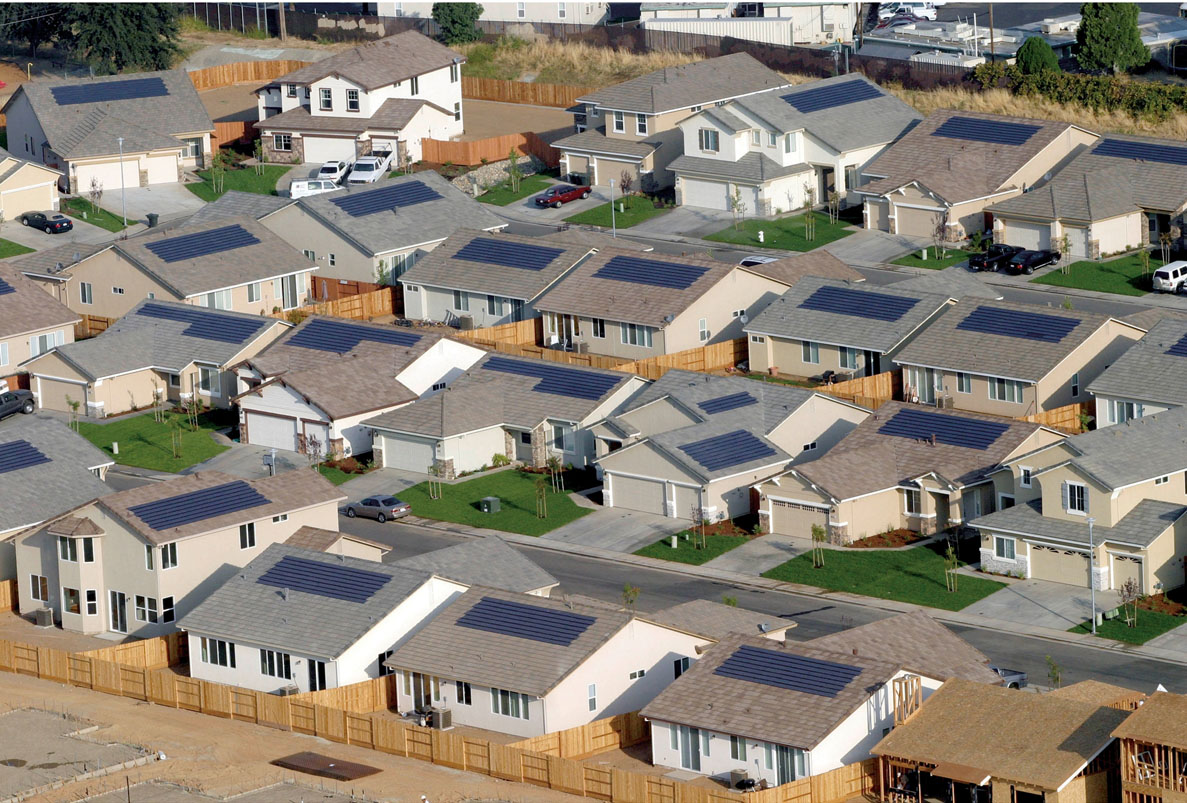By Tim Shea, Special Contributor | What is the economic impact of new solar energy standard in California?
This Wednesday, California’s Energy Commission will vote on new energy standards for all homes built after January 1st, 2020. The measure is going to pass, and, in doing so, California will become the first state to require solar panels on virtually all new houses. That mandate is itself just the cherry atop a slew of other regulations designed to promote green building practices.
Predictably, environmental activists are largely on board with the coming decision; no doubt solar installers are quite pleased as well. The job security of 100,000 solar workers aside, however, the new rules should bring about some tangible benefits, particularly in regards to reducing greenhouse gas emissions. The average residential solar array can reduce annual CO2 emissions by some 15,000 pounds per year, or roughly the equivalent of taking 1.25 cars off the road. Considering that more than 80,000 new homes are built in California each year, the long-term effects would be non-trivial to say the least.
All is not clear skies and sun shine, though; the new rules will impose some burdens as well. Estimates place the added costs for new builds at between $25,000 and $30,000, roughly half of which is due to solar. Proponents of the measure counter that these costs will be offset and then some by $50,000 to $60,000 in energy savings over a 25-year span. With that said, these claims seem somewhat…dubious. After all, if the 2:1 savings rate held true, one would expect that the market would yield a higher utilization rate than the roughly 20 percent currently seen in California. And these estimates also fail to account for the fact that much of these added costs are likely to be financed as part of an interest-accruing mortgage, or that the nation’s ongoing trade spat will result in higher prices for solar panels.
Of course, none of this addresses the real elephant in the room. That is, if you haven’t heard yet, California is in a wee bit of a housing crisis. Home prices in the Bay Area are skyrocketing by double digits annually, homelessness in Los Angeles is at a record high, and experts assess that the state is adding new housing at less than half the rate it would need to for a stable market. So, given this bleak reality, is now really the best time to be mandating pricey new building rules on residential developments?
That’s not to say that greenhouse gas reduction isn’t a laudable goal, or that it shouldn’t be a public policy priority. But housing affordability also needs to be a public policy priority, and it’s arguably a more urgent one for California. It should therefore be fair to question the wisdom of tacking an additional 8 percent to home prices in a market that is already notoriously expensive. To put it another way, is this really the optimal way to reduce the state’s carbon footprint? Or is it just a temporary expedient?
The efficacy of the solar mandate is even more questionable when one takes a hard look at the actual numbers. An optimistic estimate pegs the annual reduction in emissions at 1.3 million metric tons per year. Again, this is nothing to shake a stick at, especially when carried out over the lifetime of a home. It’s also less than half of one percent of California’s current emissions. There’s also strong reason to believe that most of the environmental benefits of the new rules will be lost once the sun goes down. So, unless homes also come equipped with a Tesla Powerwall or similar energy-storage device, the majority of residential electricity will still come from a gas-guzzling grid.
And what about unintended consequences? Maybe builders will start looking at cheaper lots farther from urban centers, thus inducing longer, carbon-heavy commutes. Maybe residents will start moving to states with even lower energy efficiency standards. Maybe, maybe, maybe…
Now maybe is, by it’s very definition, speculative in nature, and “what ifs” rarely stand alone as the foundation of good policy. At the same time, as the nation’s most populous state prepares to jack up already exorbitant home prices for a half percent reduction in CO2 emissions, perhaps “maybe” is a question we need to be asking a bit more often.
About AngelouEconomics:
AngelouEconomics has worked with numerous professional and business associations in building dozens of unique economic impact studies among other types of projects including site selection projects as well as strategic economic development projects. Some projects have examined the effects of statewide policy measures, such as the Texas Bathroom Bill or ban on Sanctuary Cities. Other projects have measured the contribution of member networks in terms of jobs, wages, and total economic output. Like this study for Prospera, a nonprofit organization which specializes in providing bilingual assistance to Hispanic entrepreneurs in Florida. Economic impact studies are effective tools for quantifying and illustrating the value of individual professional and business associations. They are versatile, as they can illustrate the value or impact of a specific policy or quantify the economic contribution of your members to the local, regional, and nationwide economies.
Want to Learn More?
If you would like to learn more send us an email at info@angeloueconomics.com














